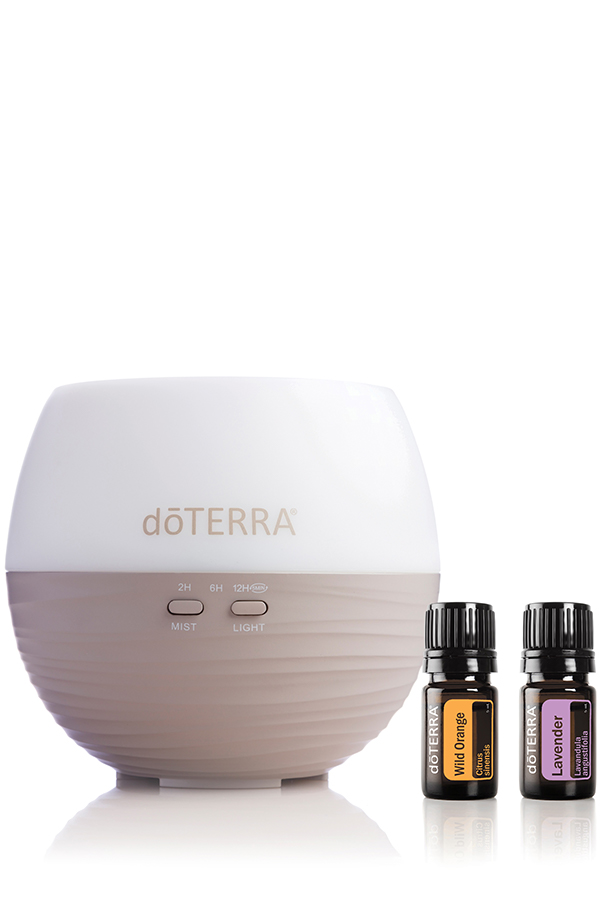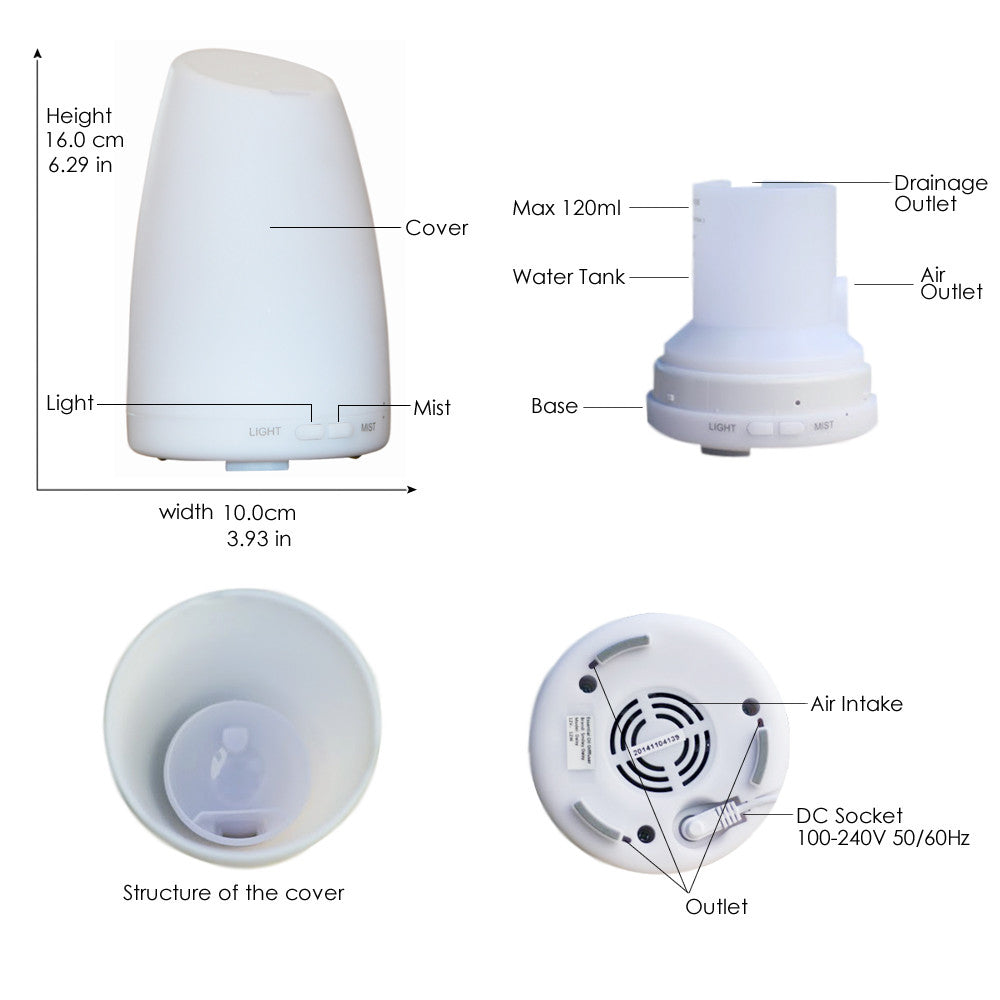Introduction
Diffusers are machines used to spread a substance over an area. These substances are normally essential oils, which are aromatic materials made from plants which is then derived as a liquid. A common way to use these essential oils is with specifically designed oil diffusers that range from different sizes and types. This includes ceramic, electric heat, reed, candle, and nebulizer diffusers, shown in Figure 1. The most familiar of these types is the ultrasonic essential oil diffuser.



Figure 1: (a) Reed diffuser (b) Ceramic Diffuser (c) Nebulizer Diffuser
Definition and Function
An ultrasonic essential oil diffuser is a device used to disperse an oil’s aroma using electric frequencies and vibrations to separate and divide the oil’s particles into smaller units to travel as a mist (Thompson, 2014). With the addition of any essential oil into the diffuser’s water reservoir, the device is able to spread the oil’s fragrance to its nearby surroundings.
Overview
Mainly all ultrasonic essential oil diffusers take the same shape. The diffusers share a plastic cylindrical body with a circular flat base. This body can be separated into one or two plastic covers that can come off. Additionally, each ultrasonic diffuser has a small circular opening at the topmost surface, a power cord depending on the battery, and a button(s) on the side of the body with a few alterations as well. These diffusers can range from 4”-7” length and width, and 4”-10” tall. Some have a wider body that becomes narrow as its height increases while others have a uniform spherical shape.
Specifically, the dōTERRA Petal Diffuser, shown in Figure 2, has a round wide body with a circular top and bottom surface. The diffuser measures at dimensions of 5.4 x 5.9 x 5.9 inches. The upper half of the body is the diffuser’s cover that is able to come off with an opaque white color with the dōTERRA branding in grey. The lower half contains the diffuser’s mist and light on and off buttons and power cord connection while the base of the Petal Diffuser consists of the air intake inlets with an uneven dark grey striping that resembles steps.

Figure 2: dōTERRA Petal Diffuser and essential oils.
Components and Explanations
Upper Body
Cover. The upper half of an ultrasonic essential oil diffuser can be composed of one to two parts with both being made of plastic. For diffusers with two parts, the structure of the cover contains an inner and outer cover. The inner cover is designed in order to focus the direction of the mist emitting out through its small circular opening while the outer cover functions as a decorative piece. Similarly with diffusers that only have one part, the cover acts as both the decorative piece and direction of mist flow.

Figure 3: Basic components of ultrasonic diffuser.
Lower Body
Base. The base of the ultrasonic essential oil diffuser consists of most of the electric pieces of the diffuser such as the circuit board and light and power switches, but it also contains the water reservoir or tank, ultrasonic disc, fan, and power cord connection. Additionally, on the bottom of the base lies the air intake inlets laid in a circular design with either a plastic or silicone pads that give the base a balanced stand.
Water reservoir. The water reservoir or tank of an ultrasonic essential oil diffuser is the component that contains the water to be added. As soon as the upper cover is removed, the water reservoir is shown. This tank can range from a capacity of 100mL to 500 mL of water with larger diffusers being able to carry up to 1000mL. In some diffusers, there is a fill line to inform the user the maximum capacity of water and to what point it should be filled to.
Drainage outlet. The drainage outlet is located on the upper lip of the water reservoir in the ultrasonic essential oil diffuser. The drainage outlet is an indented lip that allows for the drainage of the liquid in the water reservoir.
Ultrasonic disc or membrane. The ultrasonic disc or membrane of an essential oil diffuser is the piece below the water reservoir and connected to the circuit board. It is a very small circular component that has a white appearance. This circular component’s vibrations cause the oil to be broken down into smaller fragments. This disc can be made out of a ceramic material or it can be plated with silver.
Fan. The fan of an ultrasonic essential oil diffuser can be found under the ultrasonic disc or membrane. The plastic fan aids the mist and oil particles after being broken down by taking air and pushing it upwards towards the diffuser’s nozzle opening allowing the aroma to spread. Without the fan, the mist of the diffuser would not be able to rise and complete its function of dispersing across an area.
Air intake. The air intake is located at the bottom of the base of the essential oil diffuser. The air intake are the curved holes placed in a circular design that allow for air to enter the bottom of the base where it is propelled by the fan to aid the mist in dispersing to its surroundings.
Air outlet. The air outlet is located on the side of the water reservoir of the essential oil diffuser. This component functions to allow excess air generated from the fan and the air intake out of the diffuser.
Light and power switches. On the outside of the base of the ultrasonic essential oil diffuser, there can be more than one button that controls the application of the diffuser. This button controls both the intensity and duration of the mist. If capable, some diffusers have a separate button that controls the light function of the diffuser while other diffusers only have one button to control both the light and mist functions.
Circuit board. The circuit board of an ultrasonic essential oil diffuser connects the wiring of the electrical components. This includes the light and power switches, ultrasonic membrane or disc, and the rotating fan. This component is a fairly small piece relative to the size of the diffuser and is found in the base of the diffuser.
Power cord and connection. The power cord and connection of the ultrasonic essential oil diffuser can be found either on the backside of the base or the bottom of the base of the diffuser. The ultrasonic diffuser has a DC socket as the plug into the diffuser where the cord can be disconnected. On the other side of the plug for the diffuser is the plug into an outlet.

Figure 4: Diagram of separated ultrasonic diffuser and its labeled parts.

Figure 5: Diagram of the inside of a working ultrasonic diffuser.
Process
An ultrasonic essential oil diffuser is different from other oil diffusers due to its process. Once the diffuser is turned on, the ultrasonic disc or membrane begins to cause vibrations at an ultrasonic frequency. This frequency, also known as sound waves, is measured at 20kHz and is an indistinct sound that most individuals find inaudible (“Ultrasound and high frequency sound,” 2016). These vibrations agitate the water and oil mixture at an intense speed causing the large oil particles to break down into smaller particles referred to as micro-particles. The mixture of the water and oil’s micro-particles begins to turn into a mist caused by the vibrations of the disc. Next, the fan operates using air from the air intakes at the bottom of the base in order to aid the mist in rising and exiting out of the nozzle of the cover. This cycle repeats until the diffuser senses there is no longer any water in the reservoir tank and will automatically shut off.

Figure 6: Description and visual process of the cycle of an ultrasonic diffuser.
Conclusion
Ultrasonic essential oil diffusers have many benefits depending on how it is used. One method is to use the diffuser for the pseudoscience aromatherapy, which is the use of essential oils extracted naturally from plants for therapeutic purposes. In conjuncture with the diffuser, certain oils may have different effects on individuals and their surroundings. For instance, according to the National Association of Holistic Medicine, the eucalyptus essential oil can be used as an expectorant and decongestant while the lemon essential oil can be attributed to its anti-microbial and anti-stress properties (“What is Aromatherapy,” n.d.). One is not limited to using only one essential oil at a time; with the aid of an ultrasonic diffuser, a blend of essential oils can be used for its mixture of aroma and benefits. Additionally, due to the misting feature, the diffuser has humidifier traits that also moisturize its surroundings (Ariola, 2018).
While using essential oils and oil diffusers have many benefits, there are also some precautions associated with the usage. Firstly, it is advised to be careful handling and storing essential oils due to their flammability. Additionally, different essential oils can have adverse effects on certain individuals. Oils such as bergamot, tea tree, and peppermint may cause rash or irritation when applied directly on the skin (Pugle, 2019). Furthermore, other oils may be irritants to other individuals when diffused into their surroundings along with the diffuser. Those with respiratory issues including asthma should take precaution when using any form of oil diffuser. It is recommended to always consult with a medical professional before using essential oils. Another recommendation when using ultrasonic diffusers is to always use in a well-ventilated area and to dilute the oil to reduce the potency of an oil.
References
Ariola, J. (2018, May 16). The Benefits of Essential Oil Diffusers. Health Beat. https://www.flushinghospital.org/newsletter/the-benefits-of-essential-oil-diffusers/#:~:text=One%20of%20the%20best%20known,day%20and%20help%20you%20sleep.
Exploring Aromatherapy. NAHA. (n.d.). https://naha.org/explore-aromatherapy/about-aromatherapy/what-is-aromatherapy/.
Pugle, M. (2019, April 25). Are Essential Oils Safe? 13 Things to Know Before Use. Healthline. https://www.healthline.com/health/are-essential-oils-safe
Thompson, B. (2019, August 31). How an ultrasonic aromatherapy diffuser works. https://theessentiallife.com.au/theessentialblog/2014/how-does-an-ultrasonic-diffuser-work.
Ultrasound and high frequency sound. (2016, February 9). https://www.health.belgium.be/en/ultrasound-and-high-frequency-sound#:~:text=Sounds%20with%20a%20frequency%20of,ultrasound%20(or%20ultrasonic%20sound).
[Photograph of Pier 1 Reed Diffuser Sea Air™ 10oz]. (n.d.). https://www.pier1.com/products/sea-air%E2%84%A2-reed-diffuser
[Photograph of Ceramic Essential Oil Burner]. (n.d.). https://www.shopterrain.com/products/ceramic-essential-oil-burner
[Photograph of Radiance Nebulizing Diffuser for Pure Essential Oil/Aromatherapy, Premium Home & Professional Use, No Heat, No Water, No Plastic – Light Radiance by Organic Aromas]. (n.d.). https://www.amazon.com/Nebulizing-Essential-Aromatherapy-Diffuser-Professional/dp/B00OXDKG8Q
[Photograph of Petal Essential Collection]. (n.d.). https://www.doterra.com/US/en/p/petal-essential-collection
[Diagram of Ultrasonic Aromatherapy Diffuser]. (n.d.). https://majesticpure.com/products/ultrasonic-aromatherapy-diffuser
[Photograph of Aromatherapy Essential Oil Diffuser- The Daisy]. (n.d.). https://store.smileydaisy.com/products/smiley-daisy-essential-oil-diffuser-mini-cool-mist-humidifier-energy-saving-quiet-electric-ultrasonic-technology-best-fragrance-scented-oil-aromatherapy-diffuser-with-7-color-changing-led-lamps-and-mist-mode-adjustment-waterless-auto-shut-off
[Diagram of inside components of Ultrasonic Essential Oil Diffuser]. (n.d.). https://aromessential.com/best-oil-diffuser/how-it-works
[Diagram of the Process for How an Ultrasonic Diffuser Works]. (n.d.). https://www.airlifebetter.com/ultrasonic-and-nebulizer-diffusers-compared/


